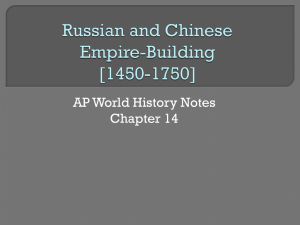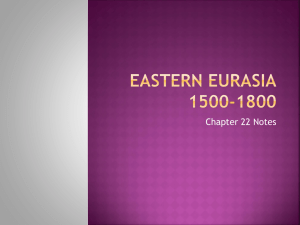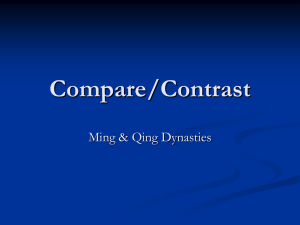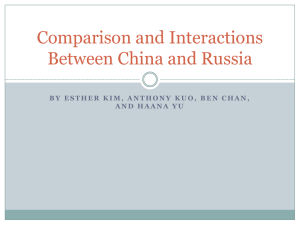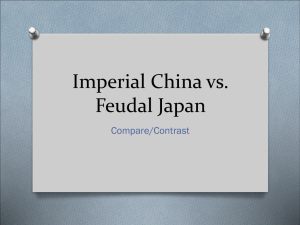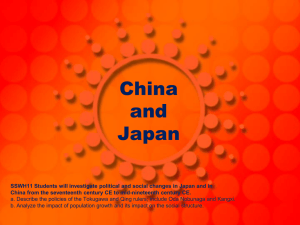File - AP World History
advertisement
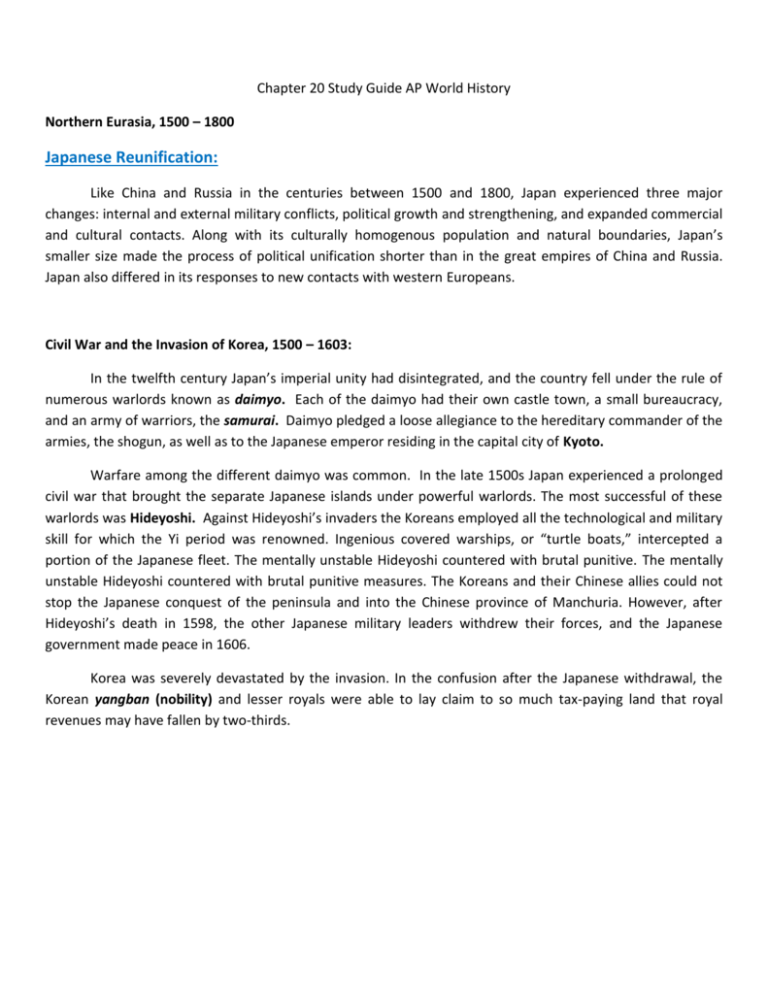
Chapter 20 Study Guide AP World History Northern Eurasia, 1500 – 1800 Japanese Reunification: Like China and Russia in the centuries between 1500 and 1800, Japan experienced three major changes: internal and external military conflicts, political growth and strengthening, and expanded commercial and cultural contacts. Along with its culturally homogenous population and natural boundaries, Japan’s smaller size made the process of political unification shorter than in the great empires of China and Russia. Japan also differed in its responses to new contacts with western Europeans. Civil War and the Invasion of Korea, 1500 – 1603: In the twelfth century Japan’s imperial unity had disintegrated, and the country fell under the rule of numerous warlords known as daimyo. Each of the daimyo had their own castle town, a small bureaucracy, and an army of warriors, the samurai. Daimyo pledged a loose allegiance to the hereditary commander of the armies, the shogun, as well as to the Japanese emperor residing in the capital city of Kyoto. Warfare among the different daimyo was common. In the late 1500s Japan experienced a prolonged civil war that brought the separate Japanese islands under powerful warlords. The most successful of these warlords was Hideyoshi. Against Hideyoshi’s invaders the Koreans employed all the technological and military skill for which the Yi period was renowned. Ingenious covered warships, or “turtle boats,” intercepted a portion of the Japanese fleet. The mentally unstable Hideyoshi countered with brutal punitive. The mentally unstable Hideyoshi countered with brutal punitive measures. The Koreans and their Chinese allies could not stop the Japanese conquest of the peninsula and into the Chinese province of Manchuria. However, after Hideyoshi’s death in 1598, the other Japanese military leaders withdrew their forces, and the Japanese government made peace in 1606. Korea was severely devastated by the invasion. In the confusion after the Japanese withdrawal, the Korean yangban (nobility) and lesser royals were able to lay claim to so much tax-paying land that royal revenues may have fallen by two-thirds. The Tokugawa Shogunate, to 1800: After Hideyoshi’s demise, Japanese leaders brought the Civil Wars to an end, and in 1603 they established a more centralized government. A new shogun, Tokugawa Ieyasu (1543–1616), had gained the upper hand in the conflict and established a new military government known as the Tokugawa Shogunate. The shoguns created a new administrative capital at Edo (now Tokyo). The domestic peace of the Tokugawa era forced the warrior class to adapt itself to the growing bureaucratic needs of the state. As the samurai became better educated, more attuned to the tastes of the civil elite, and more interested in conspicuous consumption, they became important customers for merchants dealing in silks, sake (rice wine), fans, porcelain, lacquer ware, books, and moneylending. The state attempted—unsuccessfully—to curb the independence of the merchants when the economic well-being of the samurai was threatened, particularly when rice prices went too low or interest rates on loans were too high. Japan and the Europeans: Direct contacts with Europeans from the mid-sixteenth century presented Japan with new opportunities and problems. The first major impact was on Japanese military technology. Within thirty years of the arrival of the first Portuguese in 1543, the daimyo were fighting with Western-style firearms, copied and improved upon by Japanese armorers. Japan’s civil conflicts of the late sixteenth century launched the first East Asian “gunpowder revolution.” The Japanese also welcomed new trade with merchants from distant Portugal, Spain, the Netherlands, and England, but the government closely regulated their activities. Aside from the brief boom in porcelain exports in the seventeenth century, few Japanese goods went to Europe, and not much from Europe found a market in Japan. The Japanese sold the Dutch copper and silver, which the Dutch exchanged in China for silks that they then resold in Japan. The Japanese, of course, had their own trade with China. Elite Decline and Social Crisis: During the 1700s population growth put a great strain on the well-developed lands of central Japan. In more remote provinces, where the lords promoted new settlements and agricultural expansion, the rate of economic growth far outstripped the growth rate in central Japan. Governments throughout East Asia used Confucian philosophy to attempt to limit the influence and power of merchants. The Tokugawa government, however, was at a special disadvantage. Its decentralized system limited its ability to regulate merchant activities and actually stimulated the growth of commercial activities. From the founding of the Tokugawa Shogunate in 1603 until 1800, the economy grew faster than the population. Household amenities and cultural resources that in China were found only in the cities were common in the Japanese countryside. Despite official disapproval, merchants and others involved in the growing economy enjoyed relative freedom and influence in eighteenth-century Japan. They produced a vivid culture of their own, fostering the development of Kabuki Theater, colorful woodblock prints and silkscreened fabrics, and restaurants. The ideological and social crisis of Tokugawa Japan’s transformation from a military to a civil society is captured in the “Forty-Seven Ronin” incident of 1701–1703. A senior minister provoked a young daimyo into drawing his sword at the shogun’s court. For this offense the young lord was sentenced to commit seppuku, the ritual suicide of the samurai. His own followers then became Ronin, “masterless samurai,” obliged by the traditional code of the warrior to avenge their deceased master. They broke into the house of the senior minister who had provoked their own lord, and they killed him and others in his household. Then they withdrew to a temple in Edo and notified the shogun of what they had done out of loyalty to their lord and to avenge his death. A legal debate began in the shogun’s government. To deny the righteousness of the Ronin would be to deny samurai values. But to approve their actions would create social chaos, undermine laws against murder, and deny the shogunal government the right to try cases of samurai violence. The shogun ruled that the Ronin had to die but would be permitted to die honorably by committing seppuku. The Ming Empire, 1500-1644: The brilliant economic and cultural achievements of the early Ming Empire continued during the 1500s. Ming manufacturers had transformed the global economy with their techniques for the assembly-line production of porcelain. An international market eager for Ming porcelain, as well as for silk and lacquered furniture, stimulated the commercial development of East Asia, the Indian Ocean, and Europe. But this golden age was followed by many decades of political weakness, warfare, and rural woes until a new dynasty, the Qing from Manchuria, guided China back to peace and prosperity. European merchants bought such large quantities of the high-grade blue-on-white porcelain commonly used by China’s upper classes that in English all fine dishes became known simply as “china.” The growing integration of China into the world economy stimulated rapid growth in the silk, cotton, and porcelain industries. Ming Collapse and the Rise of the Qing: Rising environmental, economic, and administrative problems weakened the Ming Empire but did not cause its fall. That was the result of growing rebellion within and the rising power of the Manchu outside the borders. Insecure boundaries are an indication of the later Ming Empire’s difficulties. The Japanese invasion of 1592 to 1598 set the Ming collapse in motion. To stop the Japanese the Ming brought Manchu troops into an international force and eventually paid a high price for that invitation. Weakened by the strain of repelling the Japanese, Chinese defenses in the northeast could not stop the advance of Manchu troops, who had already brought Korea under their sway. Taking advantage of this situation, as the opening of this chapter related, the Chinese rebel leader Li Zicheng advanced and captured Beijing. With the emperor dead by his own hand and the imperial family in flight, a Ming general invited Manchu leaders to help his forces take Beijing from the rebels. The Manchu did so in the summer of 1644. Rather than restoring the Ming, they claimed China for their own and began a forty-year conquest of the rest of the Ming territories. By the end of the century, the Manchu had gained control of south China and incorporated the island of Taiwan into imperial China for the first time. They also conquered parts of Mongolia and Central Asia. A Manchu family headed the new Qing Empire, and Manchu generals commanded the military forces. But Manchu were a very small portion of the population, and one of several minority populations. The overwhelming majority of Qing officials, soldiers, merchants, and farmers were ethnic Chinese. Like other successful invaders of China, the Qing soon adopted Chinese institutions and policies. Trading Companies and Missionaries: Different countries and companies traded with China. Portugal was the major European trader until The Dutch East India Company grew. The Dutch East India Company (VOC) had replaced the Portuguese as the major European trader in the Indian Ocean and, despite the setback on Taiwan, was establishing itself as the main European trader in East Asia. VOC representatives courted official favor in China by acknowledging the moral superiority of the emperor. They performed the ritual kowtow (in which the visitor knocked his head on the floor while crawling toward the throne) to the Ming emperor. Catholic missionaries accompanied the Portuguese and Spanish merchants to China, just as they did in Japan. The outstanding Jesuit of late Ming China, Matteo Ricci (1552–1610), became expert in the Chinese language and an accomplished scholar of the Confucian classics. Under Ricci’s leadership, the Jesuits sought to adapt Catholic Christianity to Chinese cultural traditions while enhancing their status by introducing the Chinese to the latest science and technology from Europe. From 1601 Ricci was allowed to reside in Beijing on an imperial stipend as a Western scholar. Later Jesuits headed the office of astronomy that issued the official calendar. Emperor Kangxi (r. 1662–1722): The seventeenth and eighteenth centuries—particularly the reigns of the Kangxi (r. 1662–1722) and Qianlong (r. 1736–1796) emperors—were a period of great economic, military, and cultural achievement in China. The early Qing emperors wished to foster economic and demographic recovery in China. They repaired the roads and waterworks, lowered transit taxes, mandated comparatively low rents and interest rates, and established economic incentives for resettlement of the areas devastated during the peasant rebellions of the late Ming period. Foreign trade was encouraged. Vietnam, Burma, and Nepal sent regular embassies to the Qing tribute court and carried the latest Chinese fashions back home. Overland routes of communication from Korea to Central Asia were revived, and through its conquests the Qing Empire gained access to the superior horses of Afghanistan. The Qing rulers were as anxious as the Ming to consolidate their northern frontiers, especially as they feared an alliance between Galdan’s Mongol state and the expanding Russian presence along the Amur River. In the 1680s the Kangxi sent forces to attack the wooden forts on the northern bank of the Amur that hardy Russian scouts had built. Chinese Influences on Europe: The exchange of information between the Qing and the Europeans that Kangxi had fostered was never one-way. When the Jesuits informed the Qing court on matters of anatomy, for instance, the Qing were able to demonstrate an early form of inoculation, called “variolation,” that had been used to stem the spread of smallpox after the Qing conquest of Beijing. The technique helped inspire the development of other vaccines later in Europe. Tea and Diplomacy: The Qing were eager to expand China’s economic influence but were determined to control the trade very strictly. To make trade easier to tax and to limit piracy and smuggling, the Qing permitted only one market point for each foreign sector. Thus Europeans were permitted to trade only at Canton. This system worked well enough for European traders until the late 1700s, when Britain became worried about its massive trade deficit with China. From bases in India and Singapore, British traders moved eastward to China and eventually displaced the Dutch as China’s leading European trading partner. The directors of the East India Company (EIC) believed that China’s technological achievements and gigantic potential markets made it the key to limitless profit. China had tea, rhubarb, porcelain, and silk to offer. By the early 1700s the EIC dominated European trading in Canton. Worried that their trading system would plummet, in 1792, the British government dispatched Lord George Macartney, a well-connected peer with practical experience in Russia and Indiana to China. They were sending George Macartney to try and come up with trade system revisions. Including scientists, artists, and translators as well as guards and diplomats, the Macartney mission showed Britain’s great interest in the Qing Empire as well as the EIC’s desire to revise the trade system. Shutting the British down, as well as the Dutch, French, and Russian, social tensions grew between the Chinese and the European traders. Population and Social Stress: The Chinese who escorted Macartney and his entourage in 1792–1793 took them through China’s prosperous cities and productive farmland. The visitors did not see evidence of the economic and environmental decline that had begun to affect China in the last decades of the 1700s. The population explosion had intensified demand for rice and wheat, for land to be opened for the planting of crops imported from Africa and the Americas, and for more thorough exploitation of land already in use. The Russian Empire: From modest beginnings in 1500, Russia expanded rapidly during the next three centuries to create an empire that stretched from Eastern Europe across northern Asia and into North America. Russia also became one of the major powers of Europe by 1750, with armies capable of mounting challenges to its Asian and European neighbors. The Drive Across Northern Asia: The Russians were a branch of the Slavic peoples of Eastern Europe, and most were Orthodox Christians like the Greeks. During the centuries just before 1500, their history had been dominated by Asian rule. The Mongol Khanate of the Golden Horde had ruled the Russians and their neighbors from the 1240s until 1480. Under the Golden Horde Moscow became the most important Russian city and the center of political power. Moscow lay in the forest that stretched across northern Eurasia, in contrast to the treeless steppe (plains) favored by Mongol horsemen for pasture. The princes of Muscovy, the territory surrounding the city of Moscow, led the movement against the Golden Horde and ruthlessly annexed the great territories of the neighboring Russian state of Novgorod in 1478. Once free from Mongol domination, the princes of Muscovy set out on conquests that in time made them masters of the old dominions of the Golden Horde and then of a far greater empire. Prince Ivan IV (r. 1533–1584) pushed the conquests south and east, expanding Russia’s borders far to the east through the conquest of the Khanates of Kazan and Astrakhan and the northern Caucasus region. At the end of the sixteenth century, Russians ruled the largest state in Europe and large territories on the Asian side of the Ural Mountains as well. Since 1547 the Russian ruler used the title tsar (from the Roman imperial title “Caesar”), the term Russians had used for the rulers of the Mongol Empire. The Russian church promoted the idea of Moscow as the “third Rome,” successor to the Roman Empire’s second capital, Constantinople, which had fallen to the Ottoman Turks in 1453. But such foreign titles were a thin veneer over a very Russian pattern of expansion. The natural direction for Russian expansion was the east; expansion in Siberia was led by groups of Cossacks who defeated the only political power in the region, the Khanate of Sibir, and took land from the small hunting and fishing groups of native people. Siberia was valued first for its furs and timber, after 1700 for gold, coal, and iron, and as a penal colony. In the 1650s the expanding Russian Empire met the expanding Qing Empire in Mongolia, Central Asia, and along the Amur. Treaties between the two powers in 1689 and 1727 had the effect of weakening the Mongols and of focusing Russian expansion eastward toward the Pacific coast and across to North America. Russian Society and Politics to 1725: As the empire expanded it incorporated a diverse set of peoples, cultures, and religions. This often produced internal tensions. The Cossacks belonged to close-knit bands and made temporary alliances with whoever could pay for their military services. Despite the fact that the Cossacks often performed important services for the Russian Empire, they managed to maintain a high degree of autonomy. Threats and invasions by Sweden and Poland and internal disputes among the Russian aristocracy (boyars) in the seventeenth century led to the overthrow of the old line of Muscovite rulers and the enthronement of Mikhail Romanov in 1613. The Romanov rulers combined consolidation of their authority with territorial expansion to the east. As the power of the Romanov rose, the freedom of Russian peasants fell. In 1649 Russian peasants were legally transformed into serfs. Peter the Great: The greatest of the Romanovs was Tsar Peter the Great (r. 1689–1725), who made major changes to reduce Russia’s isolation and increase the empire’s size and power. Tsar Peter is remembered for his efforts to turn Russia away from its Asian cultural connections and toward what he deemed the civilization of the West. Peter the Great fought the Ottomans in an attempt to gain a warm-water port on the Black Sea and to liberate Constantinople (Istanbul) from Muslim rule, but did not achieve either goal. Peter was more successful in the Great Northern War, in which he broke Swedish control over the Baltic and established direct contacts between Russia and Europe. Following his victory in the Great Northern War, Peter built a new capital, St. Petersburg, which was to contribute the Westernization of the Russian elites and demonstrate to Europeans the sophistication of Russia. The new capital was also intended to help break the power of the boyars by reducing their traditional roles in the government and in the army. Peter wanted to use European technology and culture in order to strengthen Russia and to strengthen the autocratic power of his government; he was not interested in political liberalization. As an autocratic ruler, Peter brought the Russian Orthodox Church under his control, built industrial plants to serve the military, and increased the burdens of taxes and labor on the serfs, whom the Russian Empire depended upon for the production of basic foodstuffs. Consolidation of the Empire: Russian expansion in Alaska and the American northwest was driven by the search for furs, which British and American entrepreneurs had also been interested in. Control of the natural resources of Siberia put the Russians in a position to dominate the fur and shipping industries of the North Pacific. During the reign of Catherine the Great (r. 1762–1796), Russia was the world’s largest land empire, built on an economic basis of large territory, agriculture, logging, fishing, and furs. Comparative Perspectives: Looked at separately, the histories of Japan, China, and Russia seem to have relatively little in common. Contacts with each other and with other parts of the world appear far less important than forces within each state. However, when examined comparatively these separate histories reveal similarities and differences that help explain the global dynamics of this period and the larger historical patterns of which it is a part. Political Comparisons: Between 1500 and 1800, China and Russia grew dramatically, both in territory controlled and population. In comparison to Russia and China, the seaborne trading empires of the Portuguese, Dutch, French, and English had less territory, tighter administrations, and much more global sweep. Despite being headed by an emperor, Japan's size, homogeneity, and failure to add colonies disqualify it from being called a true empire. Japan and Russia made greater progress in improving their military than did the Chinese. Of Japan, Russia, and China, Russia did the most to build up its imperial navy. Cultural, Social, and Economic Comparisons: As they expanded, both China and Russia pursued policies that tolerated diversity, while promoting cultural assimilation. While both Russian and Chinese leaders were willing to use foreign ideas and technologies, they tended to see their own culture as superior. Both China and Russia had hierarchical and oppressive social systems. Merchants occupied a precarious position in both China and Japan.
